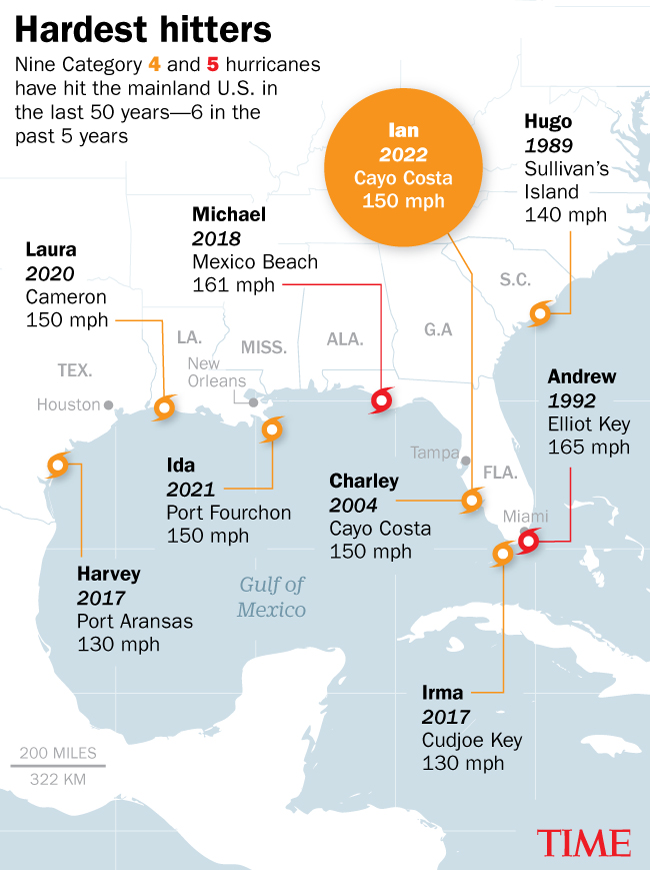Hurricane Ian devastated southern Florida on Wednesday afternoon when it hit as a Category 4 storm, causing intense flooding and leaving 2.5 million Floridians without power.
While this storm marks the most powerful hurricane seen this season, it makes history as the ninth category 4 or 5 hurricane to hit the mainland U.S. in the last 50 years—six of which have occurred since just 2017. Five of these made landfall along the Florida coastline, with Hurricane Andrew alone causing an estimated $26 billion in damages to the state in 1992. Two others have impacted Louisiana, with the remaining hitting Texas and South Carolina.
Data from the National Oceanic and Atmospheric Administration’s (NOAA) shows that there have been more than 300 hurricanes that have directly hit the U.S. coastline since 1851, of which more than 80% of those hit just three states—Florida, Texas, and Louisiana.

The frequency and intensity also varies and has been changing over time. In the span of just one year, from 2020-2021, there have been eight hurricanes to impact the continental U.S., according to NOAA data. That’s nearly half the number to hit the U.S. between 2000-2010—which saw 19 hurricanes make landfall.
And compared to three major continental U.S. hurricane landfalls out of a total 13 in the 2010s (the Saffir-Simpson Hurricane Wind Scale counts major hurricanes as those that are Category 3 or higher) there have already been four in the last two years alone.
TIME’s analysis of the frequency of Category 4 and 5 storms to hit the country, however, only takes into account hurricanes with high sustained winds. This is because the current rating scale that determines what category a storm will be does not look at other factors like rainfall and flooding—which are also becoming more intense. Thus, some catastrophic storms like Hurricane Katrina have been omitted from this list because their wind speeds were below Category 4.
Increasingly powerful storms will have devastating effects on the places we live. The National Hurricane Center warns that increased hurricane intensity can cause catastrophic damage even to well-built homes, saying total roof failure and wall collapse is highly probable once hurricanes reach Category 5 status, meaning they have sustained winds of 157 mph or higher.
Before landfall, Hurricane Ian was just 2mph short of this mark. There have only been two other hurricanes in the last 50 years—Andrew in ‘92 and Michael in 2018— that have made landfall in the U.S. mainland as Category 5.
And as the Environmental Protection Agency says, there has been a significant increase in the intensity, frequency, and duration of Atlantic hurricane activity, signaling that the South is likely to experience stronger hurricanes in the years to come. In the past five years, at least one Category 4 or 5 hurricane has made landfall in the U.S. each year.
Despite some misinformation in the media about the effect climate change has on hurricanes, the science is clear. “On the cumulative, climate change may be making storms worse,’” Maria Torres, a public affairs officer at the National Hurricane Center told TIME this week. “That is supported by the overwhelmingly clear science on what climate change means for storms like Ian in general: heavier rainfall, possible slower movement which prolongs heavy rain and battering winds, and more inundation as sea levels rise.”
More Must-Reads from TIME
- Why Trump’s Message Worked on Latino Men
- What Trump’s Win Could Mean for Housing
- The 100 Must-Read Books of 2024
- Sleep Doctors Share the 1 Tip That’s Changed Their Lives
- Column: Let’s Bring Back Romance
- What It’s Like to Have Long COVID As a Kid
- FX’s Say Nothing Is the Must-Watch Political Thriller of 2024
- Merle Bombardieri Is Helping People Make the Baby Decision
Contact us at letters@time.com